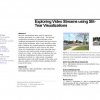94 search results - page 12 / 19 » Directions in Incident Detection and Response |
ACSAC
2007
IEEE
14 years 2 months ago
2007
IEEE
We exploit for defensive purposes the concept of darkports – the unused ports on active systems. We are particularly interested in such ports which transition to become active (...
BMCBI
2006
13 years 7 months ago
2006
Background: Gene expression microarrays allow the quantification of transcript accumulation for many or all genes in a genome. This technology has been utilized for a range of inv...
HCI
2009
13 years 5 months ago
2009
This paper describes two affect-sensitive variants of an existing intelligent tutoring system called AutoTutor. The new versions of AutoTutor detect learners' boredom, confusi...
ET
2010
13 years 5 months ago
2010
This work justifies several quantum gate level fault models and discusses the causal error mechanisms thwarting correct function. A quantum adaptation of the classical test set gen...
CHI
2009
ACM
14 years 8 months ago
2009
ACM
Slit-tear visualizations allow users to selectively visualize pixel paths in a video scene. The slit-tear visualization technique is a generalization of the traditional photograph...

